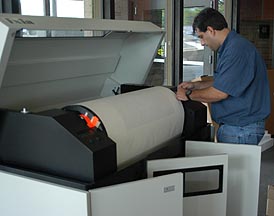 In today’s post, I’m going to be discussing the giclée print, what it is, how it’s produced, and what value it has in the wildlife art world.
In today’s post, I’m going to be discussing the giclée print, what it is, how it’s produced, and what value it has in the wildlife art world.
The word giclée (pronounced zee-clay) is derived from the French verb gicler, which means to spurt, spatter, or spew. This term is used because large format ink jet printers are used to print the giclée prints. Ink jet printers operate by means of a print head that literally sprays the ink onto the printed surface.
The ink jet printers that are used to create giclée prints are very different from your desktop ink jet printer. These printers come in sizes that can accommodate rolls of paper 60″ wide and 150′ long. They are designed to use multiple specialized ink cartridges, sometimes as many as twelve.
To begin the process of creating a giclée print, the print maker takes a digital file that was created either by scanning the original painting, or from a photograph of the original painting and loads it onto his computer. The digital file is color-corrected to ensure the colors that will be produced are accurate.
When the digital manipulation on the file is complete, the image file is sent to the giclée printer. The paper is fed through the printer as the print head passes back and forth across the sheet spraying microscopic droplets of ink onto the paper.
This process is capable of creating several million colors by mixing the different colors of ink together from the print head. Typically the offset lithographic printing process can only use four colors of ink.
The paper that is used for giclée prints is the same quality paper that is used for creating original paintings. These new large format inkjet printers are even capable of handling rolls of primed canvas.
In many cases, if a giclée print is printed on the same material that was used to create the original painting, it is very difficult to tell the print from the original.
The giclée printers are very expensive and this large investment expense drives the cost of individual prints up. For that reason, the cost of a giclée print is fairly high compared to the same size print created using the offset lithograph method, even though it is a copy of the original.
Many artists today do not sell their original paintings. They instead sell the giclée prints and keep the original paintings in their collection. Using this marketing technique allows the artist to generate greater revenue from a single painting that could be realized from the sale of the original.
Is a giclée print a good investment? Yes. It’s not going to be as valuable as an original painting, but it will be about as close as a reproduction can get in terms of value.
Until next time, keep your brushes clean, your colors pure, and as always, thanks for stopping by the North Forty.
Regards,

Thank you.


